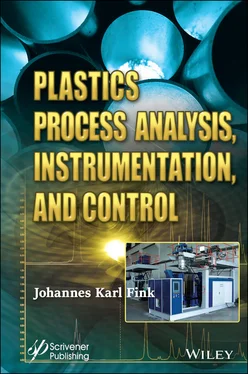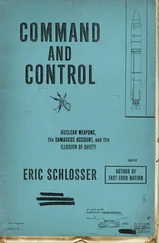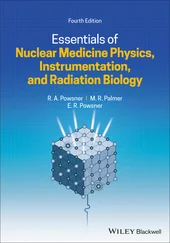1 ...6 7 8 10 11 12 ...20 A finite element model has been developed, including the nonlinear temperature-dependent magnetic data described by a three parameter modified Fröhlich equation fitted to the magnetic saturation curve, and solved with an iterative procedure.
The numerical calculations were compared with experiments conducted with two types of induction coils built into the injection molding tool. The model shows a very good agreement with the experimental temperature measurements (35).
It could also be shown that the nonlinearity can be used without the temperature dependency in some cases, and a method was proposed for estimating an effective linear permeability to use with simulation codes that are unable to utilize a nonlinear solver (35).
Multi-turn Induction Heating Coil.An integrated multi-turn induction heating coil has been developed and was assembled into an injection molding tool. This tool contained a glass window, so the effect of induction heating can directly be captured by a high speed camera. In addition, thermocouples and pressure sensors are also installed, and together with the high speed videos, the induction heating and filling of the cavity is compared and validated with simulations.
Two polymer materials, i.e., ABS and high viscosity PC, were utilized during the injection molding experiments. A nonlinear electromagnetic model was used to establish an effective linear magnetic permeability. The three-dimensional transient thermal field of the mold cavity was then calculated and compared with the experiments. This thermal field was transferred to an injection molding flow solver to compare the simulations and experimental results from the high speed video, both with and without the effect of induction heating.
A rapid thermal cycle was proved to be feasible in a mold with an integrated induction coil. Furthermore, it was shown that the process can be modeled with good accuracy, both in terms of the thermal field and in terms of the flow pattern (34).
High-Frequency Induction Heating.The recent trends of miniaturization and multifunctionality in electrical parts have driven the development of molded interconnect devices (MIDs) that contain conductive tracks on a nonconductive base (36).
A polymer/metal hybrid molding technology was developed to fabricate MIDs in a single manufacturing process, without an additional assembly procedure. For this purpose, injection molding was performed to fabricate a thermoplastic carrier that contained negative circuit channels, and die casting was used to fill the circuit channels with metal alloy of low melting point. To increase the flow length of the molten metal through the narrow circuit channel, high-frequency induction heating was used prior to the die casting stage.
The effect of heating conditions on the mold temperature was investigated numerically, and the relevant induction heating conditions were determined accordingly. Induction heating was then applied to the die casting process to increase the flow length enough to be used as a circuit path for fabrication of MIDs (36).
1.7 Microcellular Injection Molding
Injection molding is a well-established replication process for the cost-effective manufacture of polymer-based components (37). The process has different applications in the medical, automotive and aerospace fields among others. To expand the use of polymers to meet growing consumer demand for increased functionality, advanced injection molding processes have been developed that modify the polymer to create microcellular structures.
Using the creation of microcellular materials, additional functionality can be gained through polymer component weight and processing energy reduction. Microcellular injection molding shows a high potential for creating green manufacturing platforms (37).
The process conditions as well as nano/micro-fillers such as nanoclay and core-shell rubber have a strong influence on cell density and cell size, hence, the final material properties of the molded parts (38). The addition of nano/micro-fillers at optimum loading levels can generally facilitate the formation of microcellular plastics with higher cell density and smaller cell size, leading to superior mechanical properties.
The integration of a solid plastic surface with a microcellular plastic core via the co-injection molding technique has been investigated to achieve Class A surfaces and improved material performance. An improved mathematical model has been developed to simulate the cell growth behavior in the microcellular injection molding process (38).
The significant developments that have been achieved in different aspects of microcellular injection molding have been reviewed (37). The aspects covered include core-back, gas counter pressure, variable thermal tool molding and other advanced technologies. Also, the resulting characteristics of creating microcellular injection molding components through both plasticizing and nucleating agents were presented. In addition, the review highlights the potential areas for research exploitation, in particular, acoustic and thermal applications, nanocellular injection molding of parts and developments relating to more accurate simulations (37).
For cooling a heated mold, a conventionally known mold-cooling system can supply a cooling medium, such as cooling water, to a medium flow path for a mold. In such a mold-cooling system, there has been a problem of the cooling medium supplied to the medium flow path of the mold heated to a high temperature being gasified in the medium flow path and the vapor being discharged.
In order to solve the above-mentioned problem, a mold-cooling system for cooling a heated mold has been developed. This system supplies a cooling medium from a cooling medium supply source to a medium flow path provided for a mold, and a discharge side path connected to an outlet side of the medium flow path of the mold that can be communicated with a heat exchanger condensing the cooling medium gasified and discharged from the medium flow path.
This mold-cooling method suppresses the discharge of the gasified cooling medium and enhances the cooling efficiency. Figure 1.3shows a system configuration diagram of the mold-cooling system.
The mold-cooling system is constituted in such a manner that a discharge side path 15 connected to an outlet 5 side of the medium flow path 4 of the mold 2 is communicated with a heat exchanger 20 condensing gasified cooling medium discharged from the medium flow path 4.
The mold-cooling system performs heating in addition to cooling of the mold 2. The mold 2 is, for instance, made up of a fixed mold and a movable mold; the fixed mold and the movable mold are respectively provided with the medium flow paths 4, 4 for circulating cooling medium. A supply side path 13 (a medium feeding path) is connected to inlets 3, 3 (medium feeding connection ports) side of the medium flow paths 4, 4. The discharge side path 15 (a medium returning path) is connected to the outlets 5, 5 (medium returning connection ports) side of the medium flow paths 4, 4. The supply side path 13 and the inlets 3, 3 of the medium flow paths 4, 4 can be connected by a manifold portion which divides a single supply side path 13 into plurality or by flexible piping members, such as a hose or a tube, which is connected to a plurality of connection ports of the manifold portion. The discharge side path 15 and the outlets 5, 5 of the medium flow paths 4, 4 can be substantially similarly connected by a manifold portion which branches a single discharge side path 15 into plurality or by flexible piping members, such as a hose or a tube, which is connected to a plurality of connection ports of the manifold portion. The mold 2 is provided with a temperature sensor 6 as a detection means for detecting the temperature of the mold 2.
Читать дальше












